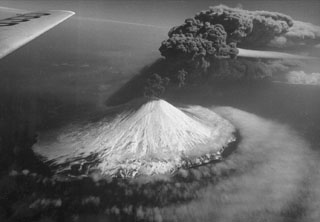Report on Alaid (Russia) — 14 August-20 August 2024
Smithsonian Institution / US Geological Survey
Weekly Volcanic Activity Report, 14 August-20 August 2024
Managing Editor: Sally Sennert.
Please cite this report as:
Global Volcanism Program, 2024. Report on Alaid (Russia) (Sennert, S, ed.). Weekly Volcanic Activity Report, 14 August-20 August 2024. Smithsonian Institution and US Geological Survey.
Alaid
Russia
50.861°N, 155.565°E; summit elev. 2285 m
All times are local (unless otherwise noted)
Although Alaid was not erupting, KVERT issued a Volcano Observatory Notice for Aviation (VONA) at 0307 on 16 August raising the Aviation Color Code to Orange (the second highest level on a four-color scale) to warn pilots of ash. Satellite images showed a plume of ash, that had been resuspend from the S flank, drifting 45 km SSE at altitudes of 2.5-3 km (8,200-10,000 ft) a.s.l. The Aviation Color Code was lowered back to Green at 0545 that same day. Dates are based on UTC times; specific events are in local time where noted.
Geological Summary. The highest and northernmost volcano of the Kuril Islands, Alaid is a symmetrical stratovolcano when viewed from the north, but has a 1.5-km-wide summit crater that is breached open to the south. This basaltic to basaltic-andesite volcano is the northernmost of a chain constructed west of the main Kuril archipelago. Numerous pyroclastic cones are present the lower flanks, particularly on the NW and SE sides, including an offshore cone formed during the 1933-34 eruption. Strong explosive eruptions have occurred from the summit crater beginning in the 18th century. Reports of eruptions in 1770, 1789, 1821, 1829, 1843, 1848, and 1858 were considered incorrect by Gorshkov (1970). Explosive eruptions in 1790 and 1981 were among the largest reported in the Kuril Islands.

